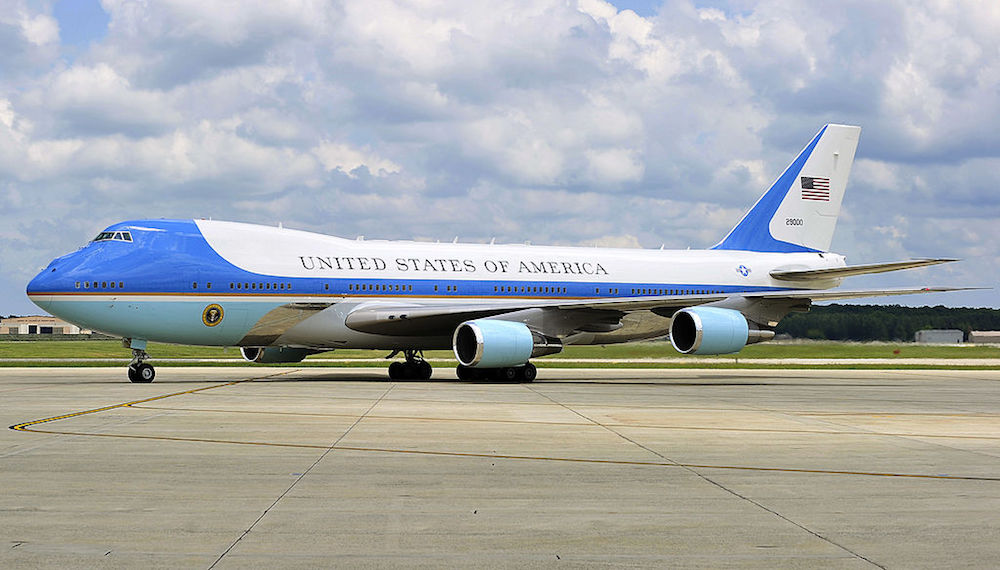Air Force One: 8 Fascinating Facts About the President's Plane

When the U.S. president needs to fly to another city or country, the primary mode of transportation is a huge 747 jetliner dubbed Air Force One. But now, a panel of aerospace and defense analysts is considering trading in the famous Air Force One jet for a smaller, less expensive aircraft to transport the president.
According to a report in Aviation Week, the suggestions for alternatives include a 737 jet by Air Force One's lead contractor, Boeing, and even a B-21 stealth bomber developed by Northrup Grumman.
President Donald Trump has criticized the Air Force One program, saying on Twitter that upgrades and replacement costs for the aircraft are "out of control." And last month, Defense Secretary James Mattis ordered a full review of the $3.73 billion presidential aircraft program, the Associated Press reported. Now, industry experts are taking note. [Flying Saucers to Mind Control: 22 Declassified Military & CIA Secrets]
According to the report in Aviation Week, major savings can be achieved by switching to smaller planes. The 737, for example, is not only smaller but also has been retrofitted for other military operations, according to Popular Mechanics.
Another proposal is to ditch the 747 for the B-21 Raider, a long-range bomber aircraft under development by Northrop Grumman. The sharp, angular design of the B-21 is based on the B-2, which was created in the late 1980s and introduced in 1997. The new B-21, which was revealed last year, improves on invisibility to radar detection and provides unrivaled shielding against conventional and electronic attacks.
But for now, the president is still using the traditional 747 jets in the Air Force One program to get around. Here are some interesting facts about Air Force One.
Technically, Air Force One is the radio call name for any plane on which the president of the United States travels. It helps avoid confusion with other planes nearby, and the naming convention was established after an incident in 1953, when Eastern Air Lines Flight 8610 flew into the same airspace as President Dwight Eisenhower's plane, which was called Air Force 8610 at the time. Today, the term "Air Force One" refers to one of two twin aircraft that are specially equipped to carry the president.
Sign up for the Live Science daily newsletter now
Get the world’s most fascinating discoveries delivered straight to your inbox.
The two current Air Force One planes are due for replacement. The planes are highly customized Boeing 747-200B series jets that were purchased under President Ronald Reagan's administration and began service in 1990 under President George H. W. Bush. But because Boeing shut down its 747-200 production several years ago, it has become extremely difficult to replace the planes' parts, according to the trade publication Defense One. That's why, during his second term in office, President Barack Obama ordered a replacement fleet for the Air Force One program that will be built based on the new 747-8 series.
The plane must be able to serve as a mobile command center. Essentially, Air Force One is a gleaming, three-level, flying Oval Office, according to the White House. The interior is modified so that the 4,000 square feet (about 370 square meters) of space includes a conference room, offices and state-of-the-art electronics for the president to be able to continue conducting operations midflight. Air Force One also has two food-preparation galleys, a medical operating room and a doctor on board every flight — just in case.
There's room for officers, staff and guests on board. In fact, Air Force One can seat up to 70 people. Plus, there are living quarters to accommodate all of the senior advisers, Secret Service officers, reporters and other guests who accompany the president.
The whole flight is considered a military operation. If the president is leaving from the White House, a Marine One helicopter usually flies the president to Andrews Air Force Base in Maryland. While in the air, Air Force One has hidden electronic jammers and flares that can be deployed to divert heat-seeking missiles, according to the Defense Media Network. And the U.S. Air Force typically sends the president's bulletproof motorcade ahead of Air Force One in a C-141 Starlifter cargo plane so that the president has access to safe transportation at the destination as well.
Air Force One can be refueled in midair. As with other combat planes, Air Force One can top off its tanks during a flight, with help from a fuel plane that arrives and hovers overhead when needed. This gives Air Force One the ability to stay up in the air indefinitely, such as if an unsafe situation is unfolding on the ground, but this is typically reserved for emergency situations, CNN reported.
It can travel at a top speed of about 600 mph (965 km/h). That's almost the speed of sound. And during flight, Air Force One can reach a maximum altitude of 45,100 feet (13,750 m). For comparison, commercial flights usually fly at an altitude of only about 30,000 feet (9,100 m).
All of the customization and facilities cost a lot. According to a Freedom of Information Act (FOIA) letter obtained by Judicial Watch, Obama's Air Force One cost taxpayers $206,337 every hour it flew. Building the replacement 747-8 jets will also be expensive — an estimated $3.73 billion over 12 years. But that's still a small portion of the entire defense budget of $8.132 trillion over that same 12-year time frame, according to Politifact. But because those costs are driven by national security concerns, they could go up in time, too.
Original article on Live Science.










